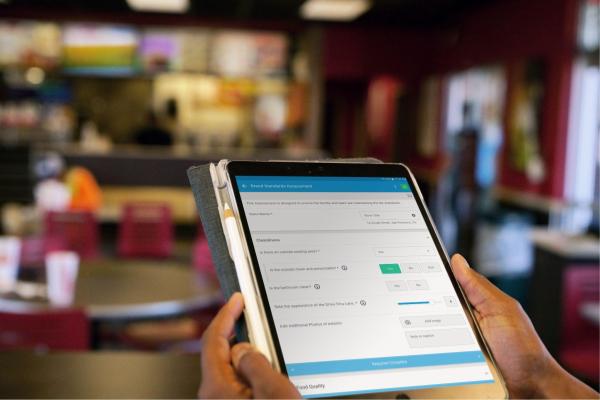
- Home
- Crunchtime Blog
- The Shift Where Everything Went Wrong

The Shift is an industry-focused blog series from contributors who share their inside perspectives on life working in foodservice and restaurants.
After working as a crew member at my local Wendy’s throughout high school, I was promoted to shift supervisor. As a college freshman, I would go to classes during the day and be Wendy’s closing manager at night.
Being new to this role, I was enthusiastic (and nervous, at first) about managing the store on my own, but I often found myself pleasantly surprised at how much I enjoyed the game — being in the flow of the team during a busy dinner rush as we were usually running like a well-oiled machine.
That is, until, the shift where everything went wrong.
Let me take you through the shift from my perspective.
3:00 PM My shift begins. I walk into the store, tired from a long school day and commute but ready to switch gears into work mode. The dining room is unusually messy, with dirty tables, an unruly condiment stand (straws and ketchup everywhere), and a floor that urgently needed to be swept and mopped.
Moving into the kitchen, it wasn’t much better, and the staff looked worn down but relieved to see me arrive. Almost nothing was stocked, and half-full sleeves of fry cartons and lids were scattered on various counters. Clearly, the day had been busy, and employees had to keep running into the back storage area in the middle of a rush to stock their stations.
3:05 PM I grab the daily schedule and immediately notice that the opening manager was the only other manager working that day, and her shift was ending in less than 30 minutes. This meant that I had to run dinner and find a way to take a break with no other managerial support. This wasn’t entirely uncommon, but it still was not ideal considering the current state of the restaurant and the unending line of cars in the drive-thru.
While writing my shift plan (assigning employees to their nightly roles, like order taker and grill operator), I flipped to the second page of the schedule and realized that, somehow, our scheduling system had mistakenly allowed the same employee to be scheduled on two overlapping shifts and no one caught it. Unfortunately, this meant I would be down a person for dinner (because, unbeknownst to the automated scheduling system, people can only be at one place at a time). I sent out a few messages to employees who weren’t scheduled that night asking them for help, but I knew the likelihood of them covering a shift would be low; it was Friday afternoon, and most people already had plans.
The Thanksgiving rush.
3:15 PM After writing the shift plan and counting the money in the safe, I reload the dashboard for our back office system to check what sales had been like that day. The data clearly showed that it had been a busy day, and each hour since lunch started had higher sales than forecasted. It was the last Friday before Thanksgiving, and because this Wendy’s is located next to a Costco, it seemed like everyone was out shopping to prepare for the holiday and stopping at Wendy’s after, contributing to the above-average sales.
3:20 PM Next, I do the walkthrough checklist, assessing different areas of the store to recognize and act on things that need to be taken care of before the upcoming dinner rush. I find there was a record-high amount of things that needed to be either cleaned or stocked throughout the store in order for us to be ready. I have to decide what was important enough to be taken care of immediately and what would have to wait until later. Ultimately, I know the store will not be going into dinner in the ideal condition, but I don’t have many good choices, so I prioritize restocking and safety issues.
3:30 PM I take over bagging orders in the drive-thru for the opening manager so she can go home. Despite being exhausted, she stayed a bit longer than scheduled to send the order taker on an overdue 10-minute break. After she leaves, I start cycling through the rest of the breaks that got missed before, I have to cover two positions at once to make it happen, but breaks are required, and the employees are more than deserving.
Unsolicited Advice.
A gentleman approaches the front counter and informs me that the table he wants to sit at needs to be cleaned. The dining room is empty with many clean, open tables, but of course, he wants to sit in front of the TV. While I follow him to the dining room and clean off the table for him, he begins a lecture about the importance of a clean dining room. Being a younger female manager, I am used to customers feeling the need to share their knowledge with me, but at this point, I don’t have the time to listen to his speech. I say, “Thank you for informing me that this table needed to be cleaned. I know the dining room isn’t up to our standards at the moment. Unfortunately, I just walked into the store for my closing shift, and I have four employees still waiting to get a break they were owed over an hour ago, and as you probably know, not giving breaks is illegal. Once we are caught up with those, I will immediately send someone out here.”
The man showed some sympathy when I told him this, and he seemed to realize that I already knew what he was trying to tell me. While my passive-aggressive response to this man was fairly tame, it was out of the blue for me. I felt bad initially and then realized that I was doing everything right. To me, taking care of employees is just as important, if not more, than taking care of customers. Not putting employees first (like cleaning the dining room before giving them a break) can make employees feel undervalued, which often leads them to look for a new job.
Over the next hour, we cycle through breaks, and I send someone out to clean the dining room. Still, the restaurant is not in the best condition, but it is better. I know it will be a long night, though, as the dishes in the back have not been done all day.
720 pieces of bacon.
4:30 PM The grill operator tells me that we are running out of bacon, and I tell him to go ahead and start cooking more. Then he tells me that there is no more prepped bacon to cook. Usually, after the morning batch of bacon gets cooked, the pans are washed and relined so that we can cook more in the afternoon, but this was another thing that hadn’t been done. I sent the fry operator to the back to wash the pans, and the grill operator helps reline the pans with bacon in between running the grill. Because we had been so busy and would continue to be busy for dinner, they had to wash, line, and cook nine batches (720 pieces) of bacon.
5:00 PM I know dinner is right around the corner, so I survey my staff. Aside from myself, only one other employee can handle bagging the huge dinner orders in the drive-thru. Unfortunately, they are also the only employee in the store who can take orders in the drive-thru, and one person physically can’t do both. New employees are working the front counter, and the fry station, so both need frequent coaching and aren't ready to take on any other position. The grill operator and sandwich maker are competent; they’re both closers who have worked at Wendy’s for a while but have no experience in customer-facing positions. I have one other employee whose shift starts at 5:30, but I realize that I will be locked in position for the night, bagging orders in the drive-thru and arranging orders for our dine-in customers, all while running the shift and putting out any (metaphorical) fires that come up.
5:15 PM Dinner arrives, and there are a huge amount of orders both in the dining room and drive-thru. Between Thanksgiving shopping at Costco, and parents picking their kids up from sports practice at the nearby high school, it seems that we are serving dinner to everyone in the area.
Frosty on the fritz.
5:45 PM Partway through the busy dinner rush, a loud metallic scraping sound comes from the Frosty machine. At first, we shrug it off, the equipment acts up sometimes, and we don’t have time to worry about it. A few minutes later, I make a vanilla Frosty and immediately notice that it looks grey. I tell employees to stop serving vanilla and turn off that half of the machine. I go to the back office and grab a flashlight to get a better look and see tiny metallic shavings. The loud scraping sound was cause for concern, apparently.
After sending a picture of the grey Frosty to my general manager, he replies to request maintenance and, if possible, to open the second machine to serve vanilla Frostys for the remainder of the night. My Wendy’s is the only one in the area with two Frosty machines because, during the summer, one machine can’t keep up with the demand, so we have a second one on standby. Luckily, a team member answered my plea to come in and help, and they start bagging orders for the drive-thru while I rush to set up the second machine, which takes around 20 minutes because I have to keep stopping to give orders to customers in the dining room.
8:30 PM The drive-thru is still non-stop, but the dining room has slowed down a bit now that the sun has set. I tell the front-counter worker to start emptying the contaminated Frosty into a bucket between guests so we can throw it out and hopefully clean that half of the machine before closing time, since now we also have to clean the other Frosty machine, too. A few minutes later, I hear a loud gasp and turn around to see Frosty mix all over the floor.
The employee had walked away as the mix was pouring into the bucket, and they forgot about it, so the bucket was now overflowing. There is vanilla Frosty mix all over the machine and pouring into a growing puddle on the floor. The employee apologizes profusely, and all we can do is laugh before they start cleaning up the mess.
12:00 AM I shut off the lights for the drive-thru menu and lock the drive-thru window. The store is closed, and now the other closers and I have to catch up. Things that should have been done hours before were just getting started as we began the long process of resetting the store.
If you work for your team, they will work for you.
2:45 AM Finally, I set the code for the alarm system and walk out of the store with the closers almost two hours later than we usually finish for the night Somehow we all made it through the shift relatively unscathed. Sure, we could have used a few more workers, and it was far from our best dinner service, but by the end of the shift, we were a more solid team than before. This shift reinforced my main service industry management philosophy: if you work for your team, they will work for you.
Unfortunately, ‘shifts where everything goes wrong’ are much more common now following the pandemic and its repercussions on the supply chain and staffing. High turnover rates across the industry lead to restaurants having less knowledgeable employees and managers, creating the perfect environment for things to go wrong. This shift, where seemingly ‘everything went wrong’ for the first time, was a good test for me as a new manager, and it helped prepare me (all at once) for the fast-paced world of running a restaurant.
It has been years since this shift, and I have encountered many more challenging shifts and situations as a manager. In reality, this shift was somewhat mild compared to some contentious pandemic-driven situations. But for me, it was the first shift where I felt that I couldn’t catch a break, and I spent the entire 12 hours just trying to keep my head (and my team) above water (and Frosty mix).
Share this post
Related


The Shift Where I Became a District Manager and Turned Chaos into Consistency

.png?width=1128&height=331&name=202304-Crunchtime-The-Shift-SM-bio%20(1).png)
